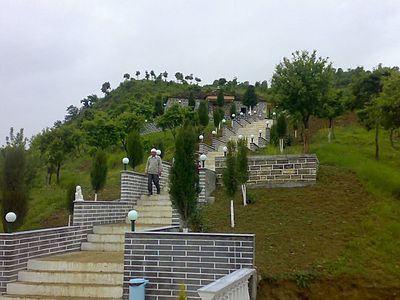Teqe of Baba Ali
| Tekke of Baba Ali | |
|---|---|
| Native name Albanian: Teqeja e Baba Aliut | |
 Stairway at the Tekke | |
| Location | Alipostivan |
| Built | 1767, rebuilt in 1857/1860 and again in 1903 |
| Architect | Baba Ali (1857/1860), Baba Abdullah (1903) |
| Part of a series on Bektashi Order Bektashi Order |
|---|
 |
The Teqe of Baba Ali (Albanian: Teqeja e Baba Aliut) or Teqe of Baba Abdullah is a Bektashi tekke in the village of Alipostivan, Qendër Piskovë, Përmet municipality. It sits upon a hill overlooking the Vjosa valley and the Nemërçka mountain, and the name of Alipostivan itself is said to derive from Ali, post i vendit (Ali, sheepskin-sitter (i.e. baba) of the place). The tekke of Baba Ali is known for the preservation and development of Bektashi traditions, particularly in spreading Bektashism to the Deshnica area and along the border villages of Skrapar. Historically, it has cooperated closely with the tekke in Frashër.[1][2]
History[edit]
The tekke is said to have been founded initially at around 1767, but the site may possibly be older due to the presence of ancient ruins which most probably sat upon an old trade route from Skrapar to Përmet. The tekke was re-founded by Baba Ali in 1857 or 1860, and it was dependent on the dedelik of Gjirokastra. It was again re-founded in 1903 by Baba Abdullah, who was originally from the tekke of Konica and whose tyrbe is still located in the teqe. Baba Abdullah (also Abdullah Babai) and baba Dule Përmeti were supporters and participants of the Albanian National Awakening, particularly in regards to the Albanian language during 1908-1909. Greek andartes burnt down the tekke in 1914, but it was rebuilt in 1920. On the 14th-17th of January, 1921, this tekke was represented by Baba Meleq at the First National Congress of the Bektashi. In 1923, it was visited by Margaret Hasluck who encountered one baba and three dervishes. It was closed in 1967 during the Communist period due to the Albanian communist party's crackdown on religion, and it was torn down by the surrounding villagers. Reconstruction began in 1997 and the tekke finally reopened in May 2003, now consisting of a large tekke and multiple large tyrbe buildings that are administered by baba Hekuran Nikollari who rebuilt it in the first place.[3][4]
Pilgrimage[edit]
In the past and the present, the tekke of Alipostivan has been an important site of pilgrimage for the Albanian Bektashis due to the fact that Abdullah Baba - considered by many in the region to be a Bektashi saint - was buried and is still venerated here. Many men in the region still bear the first name Abdullah. The Bektashi villagers of Kosinë, a village which experiences religious harmony amongst Christian and Muslim Albanians alike, gather at the tekke of Alipostivan for prayer, particularly on the feast of Novruz.[5][6][7][8]
List of leaders[edit]
- Baba Ali (founder, 1857 or 1860)
- Baba Abdullah (founder, 1903)
- Baba Hajdar Hodo and Dervish Selfo Mersini (1955-1956)
- Baba Hajdar Xhafer Kajo (1963)
- Baba Hajdar Hado and Dervish Qamil Metushi (1067)
- Baba Hekuran Nikollari (May 2003)
References[edit]
- ^ Elsie, Robert (2019). The Albanian Bektashi: history and culture of a Dervish order in the Balkans. London: I.B. Tauris. pp. 181–182. ISBN 978-1-78831-569-2. OCLC 1108619669.
- ^ Shenjtë, Selia e. "Today, the anniversary of the founding of the famous Alipostivan tekke in Përmet". Kryegjyshata Boterore Bektashiane.
- ^ Elsie, Robert (2019). The Albanian Bektashi: history and culture of a Dervish order in the Balkans. London: I.B. Tauris. pp. 181–182. ISBN 978-1-78831-569-2. OCLC 1108619669.
- ^ Shenjtë, Selia e. "Today, the anniversary of the founding of the famous Alipostivan tekke in Përmet". Kryegjyshata Boterore Bektashiane.
- ^ Nitsiakos, Vasilēs G. (2010). On the border : transborder mobility, ethnic groups and boundaries along the Albanian-Greek frontier. Berlin: Lit. p. 186. ISBN 9783643107930.
- ^ Elsie, Robert (2001). A dictionary of Albanian religion, mythology and folk culture. London: C. Hurst. p. 4. ISBN 9781850655701.
- ^ "Bektashi". Balkanistica. 13–14: 53. 2000.
- ^ Laurìa, Antonio (2020). Five Albanian villages : guidelines for a sustainable tourism development through the enhancement of the cultural heritage. Firenze, Italy. p. 59. ISBN 9788855181747.
{{cite book}}: CS1 maint: location missing publisher (link)
